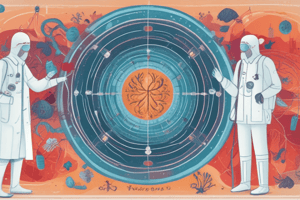Podcast
Questions and Answers
Vector-borne transmission is a type of direct contact.
Vector-borne transmission is a type of direct contact.
False (B)
The reservoir of an infectious agent can be a combination of a person and an environment.
The reservoir of an infectious agent can be a combination of a person and an environment.
False (B)
A person with a weakened immune system is not susceptible to infectious agents.
A person with a weakened immune system is not susceptible to infectious agents.
False (B)
The portal of entry is the route by which an infectious agent leaves a susceptible host.
The portal of entry is the route by which an infectious agent leaves a susceptible host.
The respiratory tract is an example of a portal of exit.
The respiratory tract is an example of a portal of exit.
The skin is not a possible portal of entry for infectious agents.
The skin is not a possible portal of entry for infectious agents.
Animals can be a reservoir of an infectious agent.
Animals can be a reservoir of an infectious agent.
A person with diabetes is not susceptible to infectious agents.
A person with diabetes is not susceptible to infectious agents.
Indirect contact is a type of airborne transmission.
Indirect contact is a type of airborne transmission.
The mucous membranes can serve as a portal of entry for infectious agents.
The mucous membranes can serve as a portal of entry for infectious agents.
Humans cannot be a reservoir of an infectious agent.
Humans cannot be a reservoir of an infectious agent.
Vector-borne transmission involves direct contact between two individuals.
Vector-borne transmission involves direct contact between two individuals.
The elderly are not more susceptible to infectious agents due to their age.
The elderly are not more susceptible to infectious agents due to their age.
Contaminated water can be a reservoir of an infectious agent.
Contaminated water can be a reservoir of an infectious agent.
The respiratory tract is not a potential portal of entry for infectious agents.
The respiratory tract is not a potential portal of entry for infectious agents.
Flashcards are hidden until you start studying
Study Notes
Chain of Infection
The chain of infection is a model used to understand the transmission of infectious diseases. It consists of six elements: reservoir, mode of transmission, susceptible host, portal of entry, portal of exit, and infectious agent.
Reservoir
- A reservoir is the natural habitat of an infectious agent
- Can be a person, animal, or environment
- Examples:
- Humans (e.g., COVID-19)
- Animals (e.g., mosquitoes for malaria)
- Environment (e.g., contaminated water for cholera)
Mode of Transmission
- The way an infectious agent is transmitted from the reservoir to a susceptible host
- Examples:
- Direct contact (e.g., touching, shaking hands)
- Indirect contact (e.g., contaminated surfaces, fomites)
- Airborne transmission (e.g., respiratory droplets)
- Vector-borne transmission (e.g., mosquitoes, ticks)
Susceptible Host
- A person or animal that is not immune to an infectious agent
- Factors that increase susceptibility:
- Age (e.g., young, elderly)
- Underlying health conditions (e.g., diabetes, HIV)
- Weakened immune system (e.g., cancer, chemotherapy)
Portal of Entry
- The route by which an infectious agent enters a susceptible host
- Examples:
- Respiratory tract (e.g., influenza)
- Gastrointestinal tract (e.g., food poisoning)
- Skin (e.g., cuts, wounds)
- Mucous membranes (e.g., eyes, nose, mouth)
Portal of Exit
- The route by which an infectious agent leaves a reservoir
- Examples:
- Respiratory tract (e.g., coughing, sneezing)
- Gastrointestinal tract (e.g., diarrhea, vomiting)
- Skin (e.g., wounds, skin lesions)
- Mucous membranes (e.g., eyes, nose, mouth)
Studying That Suits You
Use AI to generate personalized quizzes and flashcards to suit your learning preferences.




